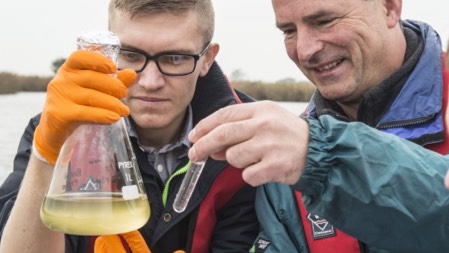Simple test set to save fish lives

A simple test to check for toxic algae is set to make huge improvements to fish health and ecosystems benefiting fish farming and angling throughout the world.
A simple test to check for toxic algae is set to make huge improvements to fish health and ecosystems benefiting fish farming and angling throughout the world.
PhD students Ben Wagstaff and Edward Hems are part of a team of researchers led by Professor Rob Field at the John Innes Centre who are developing a cost-effective and simple dip-test, giving environmental managers more regular opportunities to establish early indication of the problem.
Prymnesium, the Golden Alga, produces a toxin that is responsible for hundreds of fish kills each year, affecting still water and brackish systems like the Broads and in fish farms in temperate regions around the world.
Unlike other algae, the Prymnesium bloom is not obviously visible and the first indication is often death of fish. In 2012, Environment Agency Fisheries Officers rescued 35,000 distressed fish from the Upper Thurne area of the Broads following reports by concerned locals.
Early warning tests for Prymnesium presence are available but expensive and can take a long time to generate results.
Professor Field says: “The effect of a Prymnesium bloom on the Broads can be devastating. We have some of the largest pike in the world on the Broads, which attract anglers from all over the world. Further afield, fish farms in Norway, the US, Israel, and Asia have also felt the effect of Prymnesium on their fish stocks.”
The research project is being carried out by PhD student Ben Wagstaff who is studying the interactions between the toxin and antibodies to develop the dipstick test, as well as a related strand of research to understand what causes the algae to produce toxins.
“The dipstick test will either detect the presence of cells or the presence of compounds produced by the cells,” he says. “It’s at an early stage but there are other examples where similar tests to detect whole cells using antibodies have worked before, which is encouraging for this project.”
Dr Dan Hoare, Environment and Design Supervisor for the Broads Authority, who is responsible for ecological restoration and habitat maintenance, says: “This test will be useful for the overall health of the Broads and all its wildlife and ecosystem. Safeguarding the environment when carrying out practical projects in such a sensitive area is of prime importance. A simple test such as this would offer a rapid way of protecting fish health while ensuring that our routine maintenance work on the waterways can carry on safely.”
